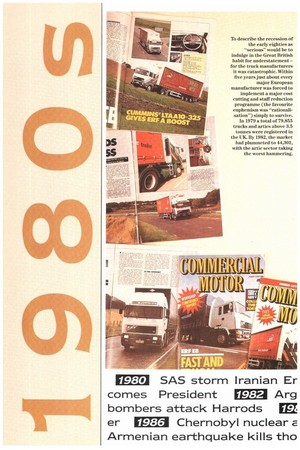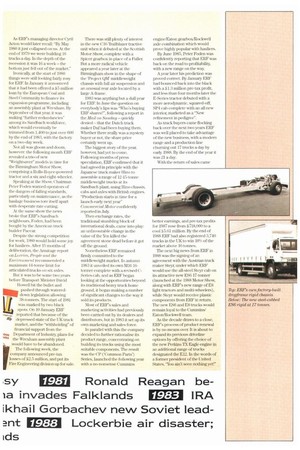To describe the recession of the early eighties as " serious "
Page 186

Page 187

If you've noticed an error in this article please click here to report it so we can fix it.
would be to indulge in the Great British habit for understatement for the truck manufacturers it was catastrophic. Within five years just about every major European manufacturer was forced to implement a major cost cutting and staff reduction programme (the favourite euphemism was "rationalisation") simply to survive. In 1979 a total of 79,855 trucks and attics above 3.5 tonnes were registered in the UK. By 1982, the market had plummeted to 44,301, with the artic sector taking the worst hammering. As ERF's managing director Cyril Acton WI add later recall: By May 19811 it just collapsed on us. At the end of 1979 we were building 16 trucks a day. In the depth of the recession it was 10 a wyek — the bottom just fell out of the market."
Ironically at the sum of 1980 things were still looking fairly rosy for ERE. In -January it announced that it had been offered a £5 million khan by the European Coal and Steel Community to finance its expansion programme, including an assembly plant at Wrexham. By September olthat yean it was making "further redundancies" among its Sandbach workforce, which would eventually he trimmed from 1,400 to just over 600 hy the end of 1983, with the factory on a two-day week.
Not all wits gloom and doom, however: the following nu 'nth ERF revealed a trio if new "Weightsaver" models in time for the Birmingham Motor Show, (4)mptising a Rolls-fhiyee-piiwered tract or and a six and eight-wlieeler.
Speaking at die Show, Chairman Peter Foden warned operators of the dangers of falling standards, pan ienlarly on maintenance, as the haulage business ()we itself apart with ilesperate rate cutting.
At the same show the news broke that ERF's Simdbach neighliours, Fl >dem had been bought by the American truck builder Pa( Tar.
Despite the strong competition for work, IMO would hold some joy for hauliers. Afier 15 months of deliberation, the Armitage report on Lorries, Pen)* and the Eolo.ironmerit NCI ffinueruled a 11ULXiIIII1111 14-tonne limit for articulated trucks on six axles.
But it was to he some two years before Thuisport Minister David I towell hit the bullet and
mapushedt lin iugh watereddown legislation allowing 384( loners. The start of 1981 was marked by two black spots. On 10 January ERF repotted that because of the depressed state of the UK truck market, and the "withholding" of financial support from the look Department of Industry plans for the Wrexham assembly plant s would have to be abandoned . IThe following week, the company announced pre-tax losses of £2.5 million, and put its Fire Engineering division up for sale. There was still plenty of interest in the new C36 Railbiazer tractive unit when it debuted at the Set sttish Motor Show, complete with a Spicer gearbox in place of a Fuller. But a more radical vehicle appeared a year later at the Birmingham show in the shape of the 'Project QM middleweight chassis with full air suspension and an unusual rear axle located by a large A-frame.
1983 was anything but a dull year EtaERE In June the question on everybody's lips was "Who's buying ERF shares?", following a report in the Mail on Sunday — quickly denied — that the Dutch truck maker Daf had been buying them. Whether there really was a mystery buyer oriim, the share price certainly went up.
The biggest St 1W (if the year, however, had yet to COilLe Following months of press speculation, ERR con1linus I that it had agreed in principle with the Japanese truck maker lImo to assemble a range of 12-1r)-tonta, middleweight trucks at its Sandhach plant, using thin CIMStijS, cabs and axles with British engines. "Production starts in nine fora launch early next year
('oat mem ial Motor confidently reported in July.
Then exchange rates, the traditional stumbling block of international deals, came into play: an unfavourable change in the value of the Yen killed the agreement stone dead before it got off the ground.
Nonetheless ERF remained family committed to I no middleweight market. In autumn 198:3 it unvei 1E41 its own MIti tonner complete with a revised CSeries cab, and as ERR began looking at the opts til unities beyond its traditional heavy truck home ground, it began making a number I a. significant changes to the way it sold its products.
Most of ERF's sales and marketing activities had previously been carried out by its dealers and distributors, but in 1983 it set up its own marketing and sales force.
In parallel with this the company decided to further rationalise its product range, concentrating on building its trucks using the most suitable components. The result was the CP ('Common Parts') Series, launched the following year with a no-nonsense Cummins engine/Eaton gearbox/Rockwell axle combination which would Tin we highly popular with hauliers.
By June 1985, Peter Roden was confidently reporting that ERE was back on the road to profitability, with a new range on the way.
A year Later his prediction was proved correct. By January ERF had bounced back into the black with a S.1.3 million pre-tax profit, and less than four months later the E-Series tractor debuted with a more aerodynamic, squared-off, SP4 cab complete with an all new interior, marketed as a "New refinement in pedigree".
As truck buyers came flocking back over t he next two years ERF was well placed to take advantage of the new business, with a modern range and a production line churning out 17 trucks a day by catty 1988. By the end of the year it was 21 a day.
With the return of sales came
better earnings, and pre-tax profits for 1987 rose from £718,000 to a cool £5.61 million. By the end of 1988 ERF had also registered 3,740 trucks in the UK to win 10% of the market al iove lb nil-tries.
The next big news from ERF in 1988 was the signing of an agreement with the Austrian truck maker Steyr, under which ERF would use the all-steel Steyr cab on its attractive new ES0 17-tonner (launched at the 1988 Motor Show, along with ERF's new range of E8 light tractors and multi-wheelers), while Steyr would receive plastic components from ERF in return. The new FS6 and E8 trucks would remain loyal to the Cummins/ Eaton/Riwkwell team.
As the decade draws to a close, EliFs process of product renewal is by no means over. It is about to expand its previous driveline options by offering the choice of the new Perkins TX Eagle engine in an additional range of trucks designated the E12. In the words of a former president of the United States, "You ain't seen nothing yet!"




































































































































































































